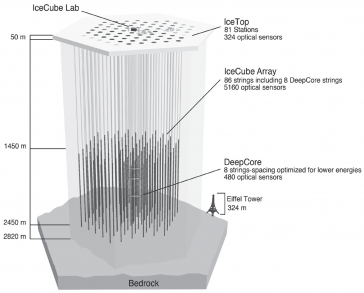
Neutrinos are elementary particles, just like electrons that buzz about atomic nuclei or quarks that combine to make protons and neutrons. They are fundamental building blocks of matter, but they don’t remain trapped inside atoms. Also unlike their subatomic cousins, neutrinos carry no electric charge, have a tiny mass, and hardly ever interact with other particles. A typical neutrino can travel through a light- year’s worth of lead without interacting with any atoms. Therein lies the snag: neutrinos are pathologically shy. Their severe reluctance to mingle makes these particles hard to pin down, so neutrino hunting is a tricky business. But every so often, a neutrino does collide with something, such as a proton inside a water molecule, essentially by accident. It is to raise the odds of accidental collisions, and thus to increase our chances of observing neutrinos, that scientists build extremely large detectors like IceCube
You still can’t see neutrinos directly, but you can get a whiff of their presence from the clues they leave behind. On the rare occasions that neutrinos do interact with matter, they produce charged particles such as muons that physicists can detect with their instruments. But distinguishing neutrino signals from unrelated “noise” poses a challenge: cosmic rays, fast- moving particles that arrive from deep space, also produce muons, which might be confused with muons produced by neutrino interactions. Neutrino hunters place their equipment deep underground, or under a thick layer of ice, so that cosmic ray muons cannot get through. As Janet Conrad of the Massachusetts Institute of Technology explains, “If you’re trying to listen to a whisper, you don’t want a lot of noise around.” -Ray Jayawardhana, The Neutrino Hunters